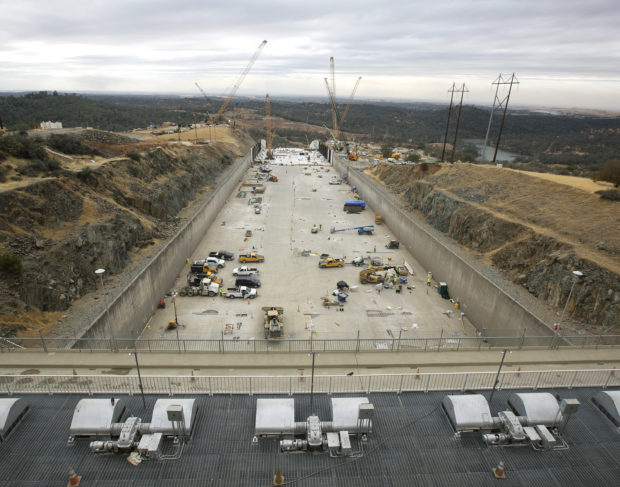
In this Oct. 19, 2017 file photo, crews work to repair the damaged main spillway of the Oroville Dam in Oroville, Calif. National dam safety experts say long-term and systemic failures by officials in California and elsewhere caused last year’s near-disaster at the nation’s tallest dam. The report released Friday, Jan. 5, 2018, comes from experts appointed to investigate the causes of spillway collapses at California’s Oroville Dam.(AP Photo/Rich Pedroncelli, File)
SAN FRANCISCO — “Long-term and systemic failures” by California dam managers and regulators to recognize inherent construction and design flaws at the tallest U.S. dam caused last year’s near-disaster there, an independent panel of dam safety experts said Friday, calling it a wake-up call for dam operators around the country.
Members of the Association of State Dam Safety Officials and the U.S. Society on Dams carried out an independent investigation into the human and technical problems that caused the crisis at California’s Oroville Dam. The experts issued their report Friday.
Both spillways at the half-century-old Oroville Dam gave way in February 2017, forcing 200,000 people downstream to be evacuated. The feared uncontrolled release of massive amounts of water over the top did not happen, and residents were allowed to return home days later.
The independent panel of safety experts said the dam was badly built from the start in the 1960s. The principal designer of the spillway told the dam-safety team that he had just completed post-graduate work at the time he worked on the Oroville project decades ago, had had no previous engineering employment beyond two summer stints, and had never designed a spillway before.
The crisis started when massive chunks of the dam’s main concrete spillway suddenly began washing away.
The report faulted California’s Department of Water Resources, which owns and operates the dam, an anchor of California’s water system, and dam regulators for allegedly failing to recognize and address problems in the 770-foot (230 meter) structure over decades of inspections and reviews.
“There were many opportunities to intervene and prevent the incident,” the experts concluded.
The state has said repairs to the structure will cost more than $500 million. Residents and businesses downstream, including in the 19,000-resident town of Oroville at the foot of the dam, have filed more than $1 billion in damage claims.
“Repairing a dam is great … but what’s happened to the view of Oroville as a safe place to live?” asked David Steindorf of American Whitewater, one of the environmental groups that had long complained that the state ignored concerns about the dam’s construction flaws. “There’s a lot of long-term impacts that need to be addressed.”
The experts said the Oroville crisis made clear that it was essential for dam managers and inspectors to review original dam construction in light of modern engineering practices.
“Like many other large dam owners, DWR has been somewhat overconfident and complacent regarding the integrity of its civil infrastructure,” the experts said.
In a statement, Joel Ledesma, a deputy director at the water agency, said state officials had supported the independent review “so we can learn from the past and continue to improve now and into the future.”
“We will carefully assess this report, share it with the entire dam-safety community and incorporate the lessons learned going forward,” Grant Davis, the agency’s director, said in the statement.
The water agency said it would assess its organizational structure as a result of Friday’s findings and already was assessing its dam-safety program.
Dam experts said the Oroville crisis is a warning for operators around the world.
“The fact that this incident happened to the owner of the tallest dam in the United States, under regulation of a federal agency, with repeated evaluation by reputable outside consultants, in a state with a leading dam safety regulatory program, is a wake-up call for everyone involved in dam safety,” the experts’ report said.
The average age of the more than 90,000 dams in the U.S. is 56 years, making thorough inspections and maintenance increasingly important for the safety of people downstream, dam experts said.